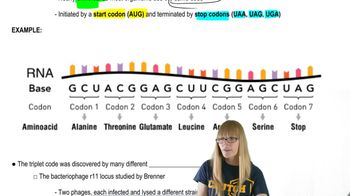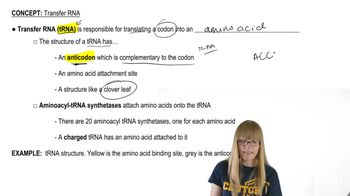The genetic code is degenerate. Amino acids are encoded by either 1, 2, 3, 4, or 6 triplet codons (see Figure 13.7). An interesting question is whether the number of triplet codes for a given amino acid is in any way correlated with the frequency with which that amino acid appears in proteins. That is, is the genetic code optimized for its intended use? Some approximations of the frequency of appearance of nine amino acids in proteins in E. coli are given in the following:
Amino Acid Percentage
Met 2
Cys 2
Gln 5
Pro 5
Arg 5
Ile 6
Glu 7
Ala 8
Leu 10
Analyze your data to determine what, if any, correlations can be drawn between the relative frequency of amino acids making up proteins and the number of codons for each. Write a paragraph that states your specific and general conclusions.
Table of contents
- 1. Introduction to Genetics51m
- 2. Mendel's Laws of Inheritance3h 37m
- 3. Extensions to Mendelian Inheritance2h 41m
- 4. Genetic Mapping and Linkage2h 28m
- 5. Genetics of Bacteria and Viruses1h 21m
- 6. Chromosomal Variation1h 48m
- 7. DNA and Chromosome Structure56m
- 8. DNA Replication1h 10m
- 9. Mitosis and Meiosis1h 34m
- 10. Transcription1h 0m
- 11. Translation58m
- 12. Gene Regulation in Prokaryotes1h 19m
- 13. Gene Regulation in Eukaryotes44m
- 14. Genetic Control of Development44m
- 15. Genomes and Genomics1h 50m
- 16. Transposable Elements47m
- 17. Mutation, Repair, and Recombination1h 6m
- 18. Molecular Genetic Tools19m
- 19. Cancer Genetics29m
- 20. Quantitative Genetics1h 26m
- 21. Population Genetics50m
- 22. Evolutionary Genetics29m
11. Translation
The Genetic Code
Problem 31
Textbook Question
A portion of the coding strand of DNA for a gene has the sequence
5′-...GGAGAGAATGAATCT...-3′
Assuming the mRNA is in the correct reading frame, write the amino acid sequence of the polypeptide using three-letter abbreviations and, separately, the amino acid sequence using one-letter abbreviations.
 Verified step by step guidance
Verified step by step guidance1
Identify the coding strand of DNA provided: 5′-GGAGAGAATGAATCT-3′. Remember, the coding strand is complementary to the template strand and has the same sequence as the mRNA (except thymine is replaced by uracil in RNA).
Transcribe the coding strand into mRNA by replacing thymine (T) with uracil (U). The mRNA sequence will be 5′-GGAGAGAAUGAAUCU-3′.
Divide the mRNA sequence into codons (groups of three nucleotides). For this sequence, the codons are: GGA, GAG, AAU, GAA, UCU.
Use the genetic code table to translate each codon into its corresponding amino acid. For example, GGA codes for Glycine (Gly), GAG codes for Glutamic acid (Glu), and so on. Write the amino acid sequence using three-letter abbreviations.
Convert the three-letter amino acid sequence into one-letter abbreviations. For example, Glycine (Gly) becomes G, Glutamic acid (Glu) becomes E, and so on.
 Verified video answer for a similar problem:
Verified video answer for a similar problem:This video solution was recommended by our tutors as helpful for the problem above
Video duration:
3mPlay a video:
Was this helpful?
Key Concepts
Here are the essential concepts you must grasp in order to answer the question correctly.
DNA and RNA Transcription
Transcription is the process by which the genetic information in DNA is copied into messenger RNA (mRNA). The coding strand of DNA serves as a template for mRNA synthesis, where adenine (A) pairs with uracil (U) instead of thymine (T). Understanding this process is crucial for translating DNA sequences into mRNA, which is the first step in protein synthesis.
Recommended video:
Translation and the Genetic Code
Translation is the process by which the mRNA sequence is decoded to synthesize a polypeptide chain, which will fold into a functional protein. The genetic code consists of codons, which are three-nucleotide sequences in mRNA that correspond to specific amino acids. Familiarity with the genetic code is essential for converting mRNA sequences into amino acid sequences using both three-letter and one-letter abbreviations.
Recommended video:
Guided course

The Genetic Code
Amino Acid Abbreviations
Amino acids can be represented using three-letter and one-letter abbreviations, which are standardized symbols used in biochemistry. For example, alanine is represented as 'Ala' in three-letter form and 'A' in one-letter form. Understanding these abbreviations is important for accurately conveying protein sequences in scientific communication.
Recommended video:
Related Videos
Related Practice
Textbook Question
581
views




